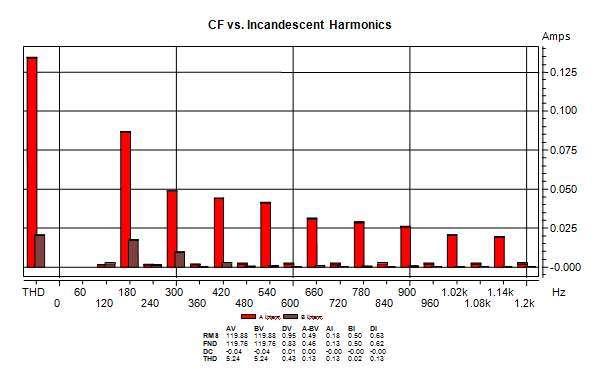With the proliferation of Compact Florescent (CF) lighting, we thought it would be interesting to do a side by side comparison to an incandescent bulb using our new Energy Platform EP1. Not only is it a great demonstration of the capabilities of the EP1 but it’s also an opportunity to explore the energy savings advantages while also looking at the potential effects on power quality.
Energy Star (www.energystar.gov) promotes the energy savings of CF lighting verses traditional incandescent bulbs. The industry claims a 75% reduction in energy usage of CF bulbs vs. incandescent. Is this true? To find out we used an EP1 to conduct a simple test to validate this claim. We randomly selected a 60W incandescent bulb and the equivalent (light output) 13W compact florescent. The CF bulb was connected to Channel A of the instrument while the incandescent was connected to channel B. Current was measured using two of our TR2501, 1A CT’s.

| CF Bulb | Incandescent Bulb | |
|---|---|---|
| Vrms | 118.6 | 118.6 |
| rms | 0.187 | 0.495 |
| W | 14.15 | 58.71 |
| PF | -0.638 | 1.000 |
| ITHd % | 106.9 | 4.14 |
As you can see from the EP1 screen capture above, the CF bulb does indeed consume 75% less energy than the equivalent incandescent. What about the power quality effects? Let’s look at the waveshapes…
From the DranView screen shot above you can see that unlike the linear resistive load of the incandescent bulb, the electronic ballast in the CF is a non linear load. Like a computer power supply, it’s rich in harmonics. There are other PQ concerns such as start up currents but we’ll focus on the harmonics since it seems to be getting the most concern.
The CF current looks quite bad with a very high current THD of about 107%. However, when taking a closer look the actual current levels are quite small. The predominant harmonic is the 3rd at about 80ma.
Will these low level harmonics cause any problems? If you Google something like “compact fluorescent thd” you’ll find numerous results on this topic. CF manufacturers claim no significant impact from such harmonics. Utilities are keeping a close eye on this issue as the proliferation of compact fluorescents continues to see if THD levels increase on their systems. One thing is clear; it will be the cumulative effects of a large number of such bulbs that would ultimately cause an issue. Even though 100+% current THD sounds bad, at such low current levels one bulb rich in harmonics clearly isn’t a problem. What happens when each house has 10, 20 or more of such bulbs operating simultaneously? That remains to be seen, hence the utilities concerns. However, as consumers, saving 75% in energy costs is the overriding factor!



















